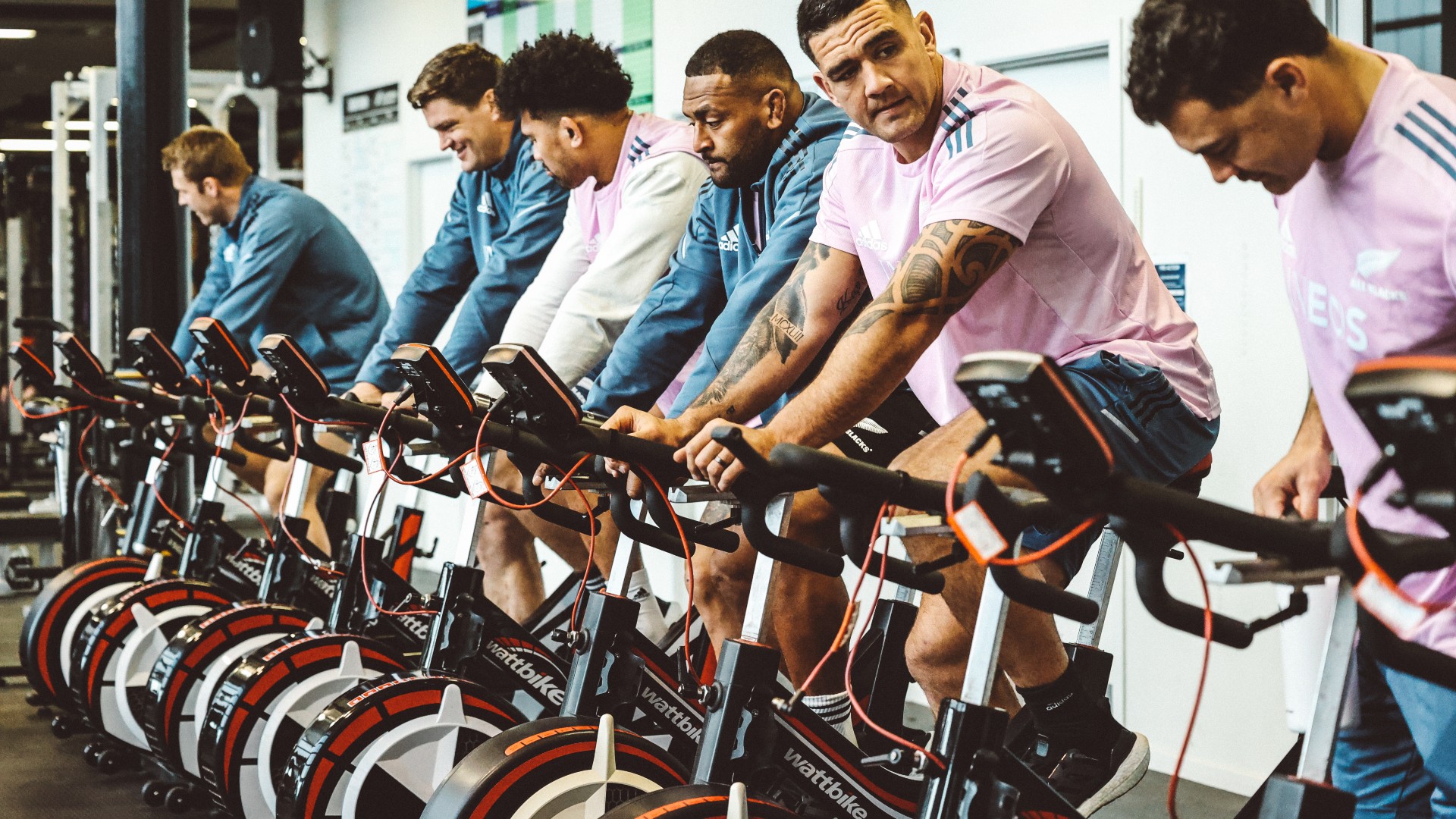
For more than 10 years, Wattbike has set the standard for indoor cycling, with its bike endorsed by British Cycling, and adopted by both elite sports teams and national gym chains. In part, that’s because it measures every pedal stroke and wheel revolution precisely to provide detailed feedback to get you fitter and faster with every session in the saddle.
The UK-manufactured bike has earned admirers all around the world – including the All Blacks’ strength and conditioning coach Nic “Gilly” Gill, who credits lung-busting sessions on the Wattbike for building stamina, grit and mental fortitude most opponents can’t live with.
But it’s not just rugby players who can benefit. The Wattbike has applications for all types of field sports and disciplines, from five-a-side football to marathon training.
Here, Gill breaks down the key metrics to monitor when using your gym’s Wattbike and details one of the All Blacks’ signature cardio sessions that has helped them win two of the past three Rugby World Cups since he joined their ranks.
How To Make The Most Of Your Gym’s Wattbike
The first metric you should track is peak power, measured in watts. The All Blacks will perform 10 x 10 second sprints on the Wattbike to mimic the demands they face in a match. The aim is to repeatedly hit a peak power output every effort, with short rest periods or low-intensity active recovery intervals between each sprint.
The key is making the peak power output match the demands you’re likely to face in your chosen discipline. “In team sports, there are periods of work that range between 10 seconds and three minutes,” explains Gill. “Using the Wattbike we can replicate these high-intensity efforts without putting undue strain on your joints.”
Another drill the Kiwis regularly use is distance over 30 seconds, measured in metres. “Its beauty is its simplicity,” says Gill. “Distance is a relevant marker no matter your sport. The challenge is posting a score in your first interval, then trying to match it in each subsequent interval as long as you can.”
Get the Coach Newsletter
Sign up for workout ideas, training advice, reviews of the latest gear and more.
Functional threshold power (FTP) is another metric it’s worth knowing. This is measured as 95% of your average power output over 20 minutes, which can provide benchmarks upon which to base cycling-specific training zones.
For example, if your FTP is 150 watts, working at 55% or less than this means you’re operating in zone 1, optimal for active recovery. By contrast, if you’re training at 120% or above this, you’re going flat out in zone 6 and boosting your anaerobic capacity.
Last, but certainly not least, you can use the Wattbike’s force output graph to improve the efficiency and balance of each pedal stroke, left versus right.
Gill uses this tool to monitor if his players are carrying any injuries or strength imbalances. “Sometimes a player returning from injury will tell me they’re fine, but the Wattbike always knows best,” he says.
All Blacks Wattbike Sprint Workout

With those metrics in mind, Gill put Coach to the test with a 35-minute interval session on the Wattbike that the All Blacks players use to build their formidable World Cup-winning fitness.
The session combines 10 x 10-second sprints with 30-second distance drills, which replicates the cardiovascular demands of professional rugby. “It will challenge your anaerobic capacity to post big numbers and aerobic capacity to recover quickly,” says Gill.
“If you do it properly with the right intensity, you should only need to repeat it once per week,” he adds, somewhat ominously. “You might feel a little light-headed and full of lactate after the first one, but as you repeat the session each week you’ll start to feel less unwell and see your numbers shoot up.”
Here’s how the All Blacks’ interval sprint session breaks down.
Warm-up
Time 8 min
Get comfortable in the saddle. Use the bike’s force output graph to optimise your pedal stroke and fully engage your hamstrings. Adjust the dampener and resistance so you can turn your legs over at a speed of around 80 revolutions per minute (RPM).
Gill says: “This is your active recovery pace, which you’ll be returning to frequently throughout the session to replenish the oxygen in your muscles.”
10-second sprint
Sets 10 Time 10sec Active recovery 30sec
Alternate 10-second all-out sprints with 30 seconds at your active recovery pace. Crank up the dampener and resistance with each sprint to help you produce the greatest peak power with each interval. If the resistance is too low you won’t be able to post decent numbers.
Gill says: “All Blacks hooker Cody Taylor and flanker Dalton Papalii set the standard, each maxing out at around 2,500 watts for a one-off 10-second sprint, or 1,500-1,800 watts for repeated efforts.” For context, Coach maxed out at 800 watts.
30-second intervals
Sets 10 Time 30sec Active recovery 1min
Alternate 30-second bursts with 60 seconds at your active recovery pace. Make a note of your distance covered in each working block and try to match it each interval. Keep pushing to the finish line.
Gill says: “On average, the All Blacks will hit 1km in 60 seconds, so around 600m in 30.” With Coach’s legs seizing up unbearably, we barely managed half of that.
Warm-down
Time 6min
Reduce the resistance and lower the dampener setting so you can turn your legs over freely, working at around 70-80 RPM, to help pump that debilitating lactate out of your thighs.
Gill says: “Your workout isn’t finished until you record your scores so you know what to beat next week – or, better yet, you can use those scores to drum up some healthy competition with your peers. If they didn’t know what the other player in their position was hitting they would never push themselves as hard.”

Sam Rider is an experienced freelance journalist, specialising in health, fitness and wellness. For over a decade he's reported on Olympic Games, CrossFit Games and World Cups, and quizzed luminaries of elite sport, nutrition and strength and conditioning. Sam is also a REPS level 3 qualified personal trainer, online coach and founder of Your Daily Fix. Sam is also Coach’s designated reviewer of massage guns and fitness mirrors.









